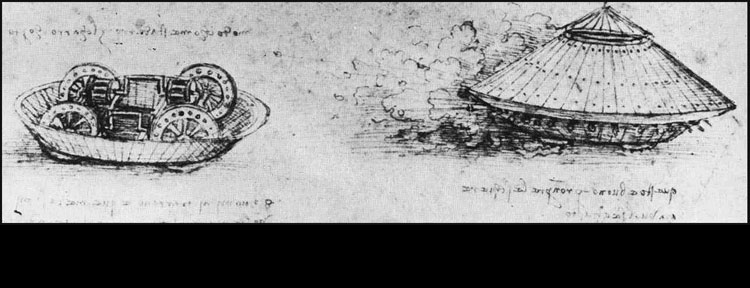





 |
 |
 |
 |
 |
 |
Leonardo's Design (ca. 1487)
A simple dissection
Roll your mouse over and click to find out more about individual parts of the armored car.

(source: Leonardo da Vinci, Codex Arundel, folio 1030, drawing no. 68: London, British Museum)
Where exactly would da Vinci's armored car work in Central Italy?
Close-up of Bird's-Eye Physical Map of Tuscany (detail) (ca.150 )
(source: Leonardo da Vinci, Royal Library, Windsor Castle: from the Corbis Collection)
Milan (source: Italy Embassy in the United States (detail))
In Leonardo's innovative physical map of Tuscany, the tank, unable to go over mountainous terrain swiftly or smoothly enough for an attack, would only have straight paths from Florence to Pisa. In Milan, the tanks may have more success--provided the many rivers are crossable by bridge.
A Study in Engineering Design Flaws
I. The Toothed Wheels-Pinions Incongruity:
Chronological Context: The inexperienced Leonardo da Vinci?
On the Codex Arundel: "This collection is housed in the British Museum in London. It consists of a manuscript on paper bound in morocco leather, containing 238 pages of various sizes that had been cut and removed from other manuscripts. The collection deals with a variety of different subjects including studies in geometry, weights and architecture. Among the latter are notes concerning the royal residence of Francois I at Romarantin (France). Most of the pages can be dated to between 1480 and 1518." (MuseoScienza)
The problem arising from Leonardo da Vinci's toothed-wheels and pinions design is surprising mostly in part due to its transparence and simplicity. Leonardo da Vinci designed the armored car in the year 1487, under the patronage of Ludovico Sforza, Duke of Milan. The postulation that da Vinci at this somewhat early stage of his career may not have a solid grasp of gear mechanics is somewhat validated by his Madrid Codices' prevalence of studies on the continuous rotary force of toothed wheels. The Madrid Codices, believed to originate from da Vinci's later years in Milan (ca. 1490-99), suggest that da Vinci not only understood the basic workings of gear mechanics, but further sought to distill and invent new usages of various mechanical 'axioms', from pinions to crankshafts. While the possibility of da Vinci's being mechanically inexperienced during the time of the drawing remains, the inexact chronology of da Vinci's work leaves room for question on whether his skills (or lack thereof) was the culprit behind the gear design flaw. |
(sources: Clockwise from top right: Madrid Ms. I (BNM), folio 13r (detail); Madrid Ms. I (BNM), folio 15v (detail); Madrid Ms. I (BNM), folio 15v (detail); Codex Atlanticus (BAM), folio 77v (detail); Madrid Ms. I (BNM), folio 17r (detail): [Galluzzi, Paolo, Renaissance Engineers from Brunelleschi to Leonardo da Vinci. , p. 199]) |
II. Political/Intellectual Intrigues.
Leonardo da Vinci's letter to Ludovico Sforza. |
Other seemingly flawed engineering design include the impractical wheels, the crank system and the conical shaped armor. The wheels, too thin and too insupportable for the armored enclosure, would sag in soft terrain and stumble over rocky ground. The coordination of cranking the wheel system is also difficult to synchronize, rendering the tank's motion slow and jerky. The guns too if radially arranged seem more likely to miss or hit allied troops as well enemy soldiers. The conical shape of the armor--without any peepholes--seems more decorative rather than functional. The precise placement and shape of the planks would have meant that manufacturing the tanks en masse would have been prohibitive. Yet if the tank's purpose is indeed to seem "safe and unattackable", as da Vinci detailed in his cover letter to Ludovico Sforza, the entirely covered car with a large number of men would have satisfied political ambitions. More than as a symbol of military prowess than actual technological function, the 'covered chariot' is indeed an intimidating sight to behold. On the other hand, the drawing has often been described by historians as fanciful. And perhaps we should leave it as such--a fantastical exploration of a moving chariot that bears more than a passing resemblance to the cars and tanks of today. |